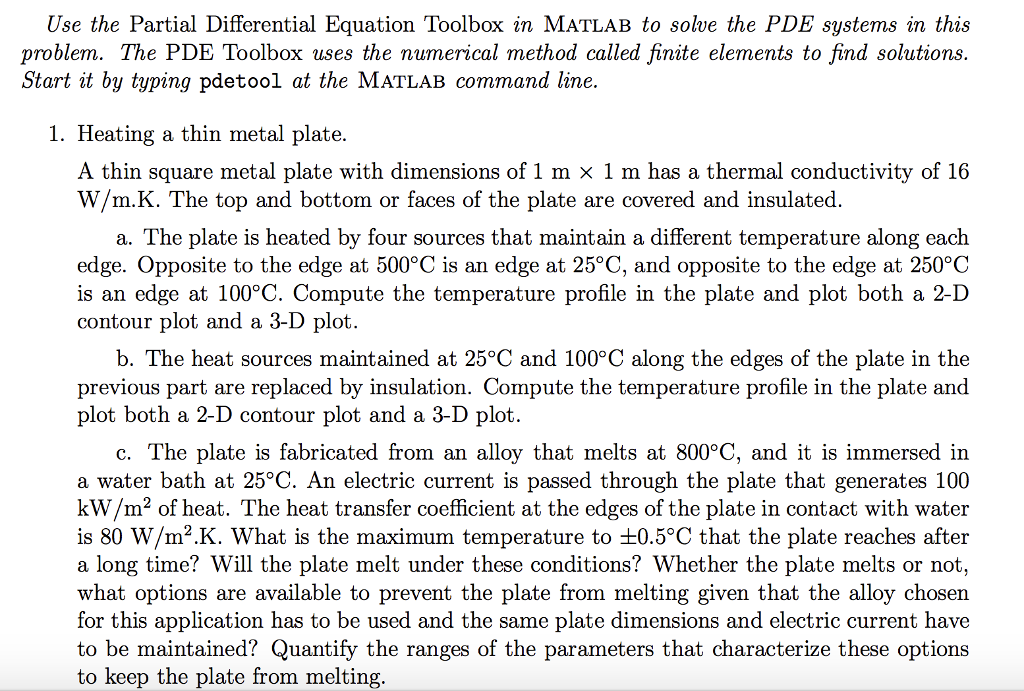
Use the Partial Differential Equation Toolbox in MaTlAB to solve the PDE systems in this problem. The PDE Toolbox uses the numerical method called finite elements to find solutions Start it by typing pdetool at the MaTLAB command line. 1. Heating a thin metal plate A thin square metal plate with dimensions of 1 m 1 m has a thermal conductivity of 16 W/m.K. The top and bottom or faces of the plate are covered and insulated. a. The plate is heated by four sources that maintain a different temperature along eaclh edge. Opposite to the edge at 500C is an edge at 25C, and opposite to the edge at 250C is an edge at 100C. Compute the temperature profile in the plate and plot both a 2-D contour plot and a 3-D plot b. The heat sources maintained at 25C and 100C along the edges of the plate in the previous part are replaced by insulation. Compute the temperature profile in the plate and plot both a 2-D contour plot and a 3-D plot. c. The plate is fabricated from an alloy that melts at 800C, and it is immersed inn a water bath at 25C. An electric current is passed through the plate that generates 100 kW/m2 of heat. The heat transfer coefficient at the edges of the plate in contact with water is 80 W/m2.K. What is the maximum temperature to 05C that the plate reaches after a long time? Will the plate melt under these conditions? Whether the plate melts or not what options are available to prevent the plate from melting given that the alloy chosen for this application has to be used and the same plate dimensions and electric current have to be maintained? Quantify the ranges of the parameters that characterize these options to keep the plate from melting Use the Partial Differential Equation Toolbox in MaTlAB to solve the PDE systems in this problem. The PDE Toolbox uses the numerical method called finite elements to find solutions Start it by typing pdetool at the MaTLAB command line. 1. Heating a thin metal plate A thin square metal plate with dimensions of 1 m 1 m has a thermal conductivity of 16 W/m.K. The top and bottom or faces of the plate are covered and insulated. a. The plate is heated by four sources that maintain a different temperature along eaclh edge. Opposite to the edge at 500C is an edge at 25C, and opposite to the edge at 250C is an edge at 100C. Compute the temperature profile in the plate and plot both a 2-D contour plot and a 3-D plot b. The heat sources maintained at 25C and 100C along the edges of the plate in the previous part are replaced by insulation. Compute the temperature profile in the plate and plot both a 2-D contour plot and a 3-D plot. c. The plate is fabricated from an alloy that melts at 800C, and it is immersed inn a water bath at 25C. An electric current is passed through the plate that generates 100 kW/m2 of heat. The heat transfer coefficient at the edges of the plate in contact with water is 80 W/m2.K. What is the maximum temperature to 05C that the plate reaches after a long time? Will the plate melt under these conditions? Whether the plate melts or not what options are available to prevent the plate from melting given that the alloy chosen for this application has to be used and the same plate dimensions and electric current have to be maintained? Quantify the ranges of the parameters that characterize these options to keep the plate from melting







